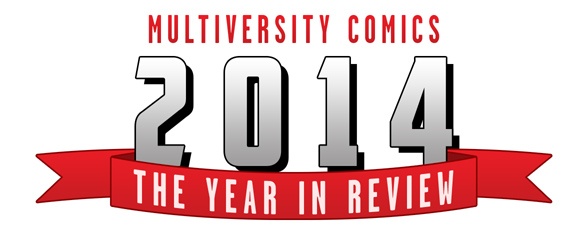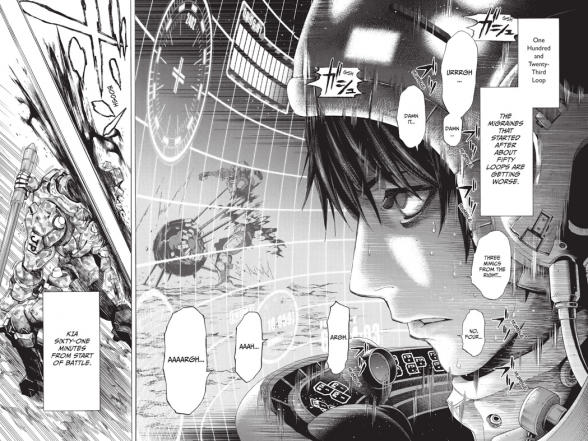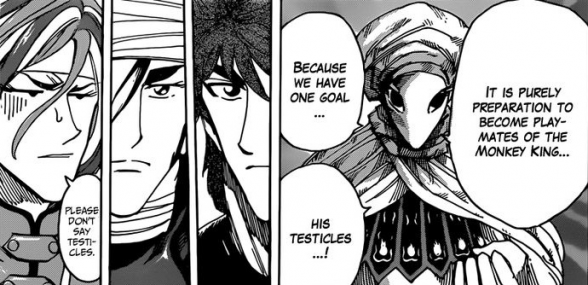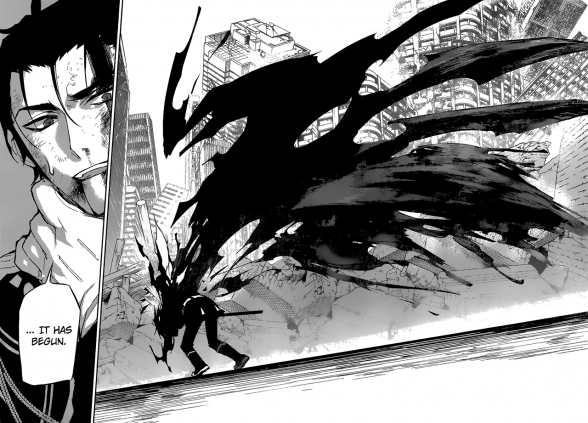
2014 in Review has ended, but there are still tons of things Multiversity’s staff loved in comics from the year. As we approach the end of the year, Multiversity’s staff will share one thing a day they loved from the year, highlighting anything from a comic, creator, cover, comic shop, app, or anything really. As long as it involved comics, it can be featured. We hope you enjoy.
As you may have noticed, Multiversity does a yearly holiday gift guide, where various contributors offer holiday gift suggestions for the nerds in your life. Last year, Mike Romeo’s first pick was a subscription to Weekly Shonen Jump, Viz Media’s digital manga magazine, and I took him up on his suggestion — as a gift to myself. Like most kids growing up in the 90s, I was raised on a steady diet of Dragon Ball Z, Gundam Wing, and Pokemon, and as a young adult I have accumulated a small collection of Urasawa, Otomo, and Tezuka comics, but this was my first step into actually staying up to date with what was current in manga. Indeed, as a law school student without much time to make it to the local comic shop, I ended up staying more up to date with Shonen Jump than I did with most of the American comic series I was reading. Read on for my impressions of the various new series I have been exposed to after a year as a Weekly Shonen Jump reader. As I’m covering over a dozen series in less than 3,000 words, it may be a general in points, but hey, isn’t that what year in review articles are all about?
American manga fans talk a lot about Shonen Jump‘s “Big Three:” “One Piece,” “Naruto,” and “Bleach.” But when I first started my Shonen Jump subscription, I didn’t have much interest in at least two of the three, and that hasn’t changed. That’s right, I didn’t read the Naruto finale at all (don’t look at me like that, I’m semi-retired from comics journalism, I don’t have to read things I’m not interested in anymore). I did usually at least flick through it, because Masashi Kishimoto’s use of thin lines is visually interesting, but the series doesn’t seem like my cup of tea. “Bleach” I eventually stopped even skimming for the art — what I’ve seen of the earlier chapters looks neat, but it seems that Tite Kubo’s art has suffered as he nears the series’ end. So what about “One Piece?” As it is a series that has been running for over fifteen years, I have no idea what is going on in “One Piece,” and, quite frankly, I don’t really care. But this is the good kind of “I don’t care!” Eiichiro Oda’s world is so bizarre that it is fascinating, and his art is an outlandish delight, with some of the craziest expressions in comics (though sometimes his characters, particularly the women, can look a bit same-y). That being said, I do hope this arc that began before I started my subscription and still hasn’t ended wraps soon — eventually the novelty will wear off, and I’ll want to actually understand what I’m reading.

If the “Big Three” are either finished, uninteresting, or convoluted, then was it still worth it for me subscribe to Shonen Jump? You bet. One of the highlights of 2014, and probably my highest recommendation to any western comic fan interested in seeing what manga has to off, was “All You Need Is Kill,” an adaptation of the light novel of the same name (you might know it better as the recent Tom Cruise blockbuster Edge of Tomorrow). The adaptation was illustrated by Takeshi Obata, of “Death Note” fame, based on story boards by Ryōsuke Takeuchi and the original character designs of Yoshitoshi ABe. Obata is one of the stars of manga, due to the widespread popularity of “Death Note,” and this brutal sci-fi series shows him in fine form. Whether you are a fan of the film or like the idea of Groundhog Day, only it’s a soldier continually waking on the field of a losing war, I’d highly recommend the recent paperback collecting the entire series (hey, not all manga series are billions of pages long). A word of warning, though: for whatever reason, the story was adapted twice by Viz, and the earlier version has been widely panned, so make sure you pick up the Obata adaptation.
Continued belowDid you like Dragon Ball Z? Remember how Goku was always hungry and would eat a lot when the world wasn’t in danger? Do you wish the series had been about that instead? Well, you may be in luck. “Toriko” is shonen with a capital S: you have your standard group of super powerful burly men with over-the-top powerful abilities, one of whom is an edgy anti-hero, plus their small, but kind-hearted buddy, and they travel to exotic locations to face threats that scale in power level to an absurd degree, all while learning about the power of friendship. The twist, however, is the monsters Toriko and his friends fight then become their dinner. Creator Mitsutoshi Shimabukuro is clearly a man who loves food, and in his series he comes up with all sorts of crazy ideas for exotic beasts (often using submissions from fans, as well), all for the purpose of having his gourmet hunters turn them into equally wild meals. The series is far enough along that, like “One Piece,” there’s enough history that the story sometimes relies on the past, but I very rarely felt lost. Toriko is trying to find all the ingredients for his perfect full-course meal? Got it, let’s go. Everything in this series is turned up to 11, so maybe it isn’t for everyone, but goddamn is it entertaining.

Another popular newer series is “World Trigger,” which has recently made its anime debut. “World Trigger” follows a young agent of Border, an organization that protects the world from “Neighbors” from bordering realities, and his friend and teammate, a humanoid Neighbor. It’s easy to see why “World Trigger” is popular; along with its pretty unique story, it has an engaging battle system of sorts with somewhat video-gamey aspects. The soldiers of Border and the opposing neighbors are equipped with various “triggers,” or special abilities, that require certain amounts of MP– er, I mean “trion” in order to activate depending on how powerful the trigger is. It is also very tactics heavy; nearly all of its 2014 chapters were devoted to a single large battle against Neighbors, focusing on various members of Border as they were spread out across the battlefield, working as units to save the day. Daisuke Ashihara’s art is crisp and clear, keeping the (very) protracted battles moving, rather than stagnant. While it had a good year in 2014, it will be nice to see the plot move beyond that huge battle in 2015.
Although “World Trigger” seems to be the more popular hit, I think I’m more of a fan of “Seraph of the End,” which also has an anime forthcoming. It’s a pretty standard action series, with some post-apocalyptic fantasy and horror thrown in, in a world where vampires reign and most humans are merely cattle — except, of course, those willing to fight back. I suppose it isn’t particularly unique –you have your band of young heroes, each equipped with powerful and dangerous weapon, learning to work together as a team and confront their tragic pasts — but every chapter this year was a visual treat from artist Yamato Yamamato (though the female designs can be a bit gratuitous). The script can sometimes be a bit groan-worthy, but I’m not sure if that’s so much on writer Takaya Kagami as it is on Viz’s translators. Even so, Kagami delivered some hard-hitting moments, with the main character, Yuichiro, discovering that his childhood friend had become a vampire, and I imagine there will be more tugging on my heart strings in 2015.

Not everything in Weekly Shonen Jump is action-packed, however. “Nisekoi” is the current romantic comedy running in the magazine, and is your standard harem comedy: you have your male protagonist who is a good-hearted guy who has little in the way of defining traits besides being nice, his comic relief best friend, and a wide cast of female characters who almost all have a thing for the protagonist, whether secretly or very, very obviously. The whole shtick of this particular one is that Raku, the protagonist, is the son of a Yakuza leader, and he has to pose as the boyfriend of Chitoge, one of the main female characters and the daughter of another gang leader, in order to prevent their families from fighting. However, Raku owns a locket that can only be unlocked by a key a girl from his childhood owns… only, he can’t quite remember who that girl is. I’ll admit, this didn’t seem like my kind of thing when I first started, but Naoshi Komi’s series can be both legitimately funny and sweet, and might be one of the stronger series currently going. Its main fault — and I fully recognize that this is not a fault for most of the target demographic — is that it can go overboard with its fan service. Maybe when I was thirteen or fourteen this would have been a plus, but all it does for me now is make me roll my eyes (though it looks like the show goes even further, somehow). Still, it’s a fun series that I’m glad is in the magazine to add some diversity, though I wouldn’t buy it in individual paperbacks.
Continued belowOne of the newer series is “Food Wars,” which takes the tropes of a tournament fighting manga and applies it to a culinary school. Whereas “Toriko” is bombastic and not at all based on the food sciences, “Food Wars” actually goes into detail about the preparation of various dishes, including the how and why — it’s Good Eats meets the obligatory tournament arc of your favorite late 90s/early 2000s anime. As a bit of a foodie, this series has been one of my favorite additions; however, it began in the American Weekly Shonen Jump mid-series less than two months ago, so I’m still not up to date on the plot. Nevertheless, the combination of the educational value and intensity has me adding all the preceding paperbacks to my Amazon wishlist.

In early 2014, Weekly Shonen Jump wrapped up its reprint of the Saiyan Saga of “Dragon Ball” in full color. If you were a fan of the television show, I highly recommend tracking down these three paperbacks. Normally, I find colored versions of comics that were originally black and white to be less than impressive, but Akira Toriyama’s clean line work works well with color, and the end result is quite impressive. Similarly, later 2014 saw the start of a new feature called Jump Back, where Viz serializes the first few chapters of some of their classic series across a few issues, in order to expose them to a new audience (and, let’s be real, to get you hooked so you go and buy the rest once it’s done). And so far it has done its job — I’m definitely interested in checking out more of the first two series that were given this treatment, “Jojo’s Bizarre Adventure” and “Death Note” (“Naruto,” not so much). Viz already offers the first chapters of most of their series digitally for free, but this approach is, in my opinion, smarter — with western comics, the first issue often isn’t enough to get a full feel on whether you like it or not, whereas the near-equivalent of the first paperback is usually enough to make you decide “yes, more of this, please.”
Another new feature in 2014 was the Jump Start initiative, where a few series currently running in Japan had their first few chapters translated, and fans would then vote on what they wanted added to the American Weekly Shonen Jump lineup. It’s a neat idea, but like most democratic approaches to entertainment, it means that your least common denominator series are going to be the clear winners. I enjoy the winner of the first round, Ippei Goto’s “Hi-Fi CLUSTER,” but it does kind of scratch a similar itch as “World Trigger,” with its video game-like “cluster” power-ups (the artistic style, however, is very nice). The next winner, “Gakkyu Hotei: School Judgement” could not lose: illustrated by previously-mentioned fan favorite Takeshi Obata, it was no contest. In my opinion, though, it’s just an even more contrived Phoenix Wright: Ace Attorney with even more ridiculous designs and set in a school (and I love the Ace Attorney series). However, I fully admit that I may be biased against it because it beat what was in my opinion the best new comic series of 2014, Takujō no Ageha, a series about a young man who is a table tennis prodigy at the expense of anything else that is good in life.

I mean, come on, no school-based courtroom drama can beat that.

And then there’s “One-Punch Man.” Oh boy is there “One-Punch Man.” Superheroes may be the hallmark of American comics, but it is certainly possible that the best current ongoing superhero comic is coming out of Japan. “One Punch Man” follows a young superhero named Saitama, a plain looking guy with one hell of a superpower: he can defeat any enemy with a single punch. While Saitama is a true hero, he also is bored — protecting the innocents is great and all, but it would be nice if there was some challenge. Through most of 2014, Saitama and the Heroes Association fought back against an alien invasion, but the most recent, uproariously funny arc had the titular character meet the legendary hero known only as King (who turned out to just be a normal, extremely lucky guy). “One-Punch Man” is probably everything I want in a superhero comic: it has a unique hook, it’s hilarious, but also has an engaging story, and good lord Yūsuke Murata’s art is incredible. The contrast between the drab Saitama and the comics’ other, hyper-detailed characters is a clever stylistic touch and Murata breaks down some of the more intense moments into a series of full page spreads that are easily .gif-able.
Continued below
Gif source.
Sure, not everything in Weekly Shonen Jump was great this year. One of the more popular newer series, “Blue Exorcist,” does nothing for me. Like “Seraph of the End” and “Bleach,” it is an action series with a horror veneer, but it seems to dip into horror a bit more than the former. However, I’d say this hurts it more then it helps, because the execution is not particularly effective, making it all the more apparent that it’s just dressing. There was also a new, kitchen-sink style sci-fi/fantasy series called “Stealth Symphony” that was, to put it lightly, an unfocused mess. The worst part about it, though, was that I planned to stop reading it, then it got interesting, and then… it ended. Then there’s some Yu-Gi-Oh series, which I have never bothered to read. Interestingly enough, this series was never the cover story in 2014 — not exactly a sign of faith on Viz’s part.
So, with me admitting that I skipped a few of the series and skimmed some others, was my 2014 Weekly Shonen Jump subscription still a good purchase? You bet. In fact, I’d go so far as to say it was probably the single best comic purchase I made in 2014. If you didn’t follow the link at the top of the page to our 2013 gift guide, a year of Weekly Shonen Jump is $25.99. As the title suggests, it is a weekly magazine, with only four weeks off, and the magazine regularly runs over 200 pages. After a year, that’s between 9,000 and 10,000 pages of comics, all for $26 — sometimes cheaper, when they have a sale. I’d pay $26 a year just for “One Punch Man” and “World Trigger” — the rest is just a lot of icing on a delicious cake. If you’re a western comics fan looking to add something different to your plate in 2015, now might be the best time to dip your feet into what is coming out of Japan. A word of advice, though: Viz has a ” starter pack” that they update near the beginning of each year which has either the first chapter or the beginning of the current arc for each series currently running in the magazine. The starter pack currently available is for 2014, so it may be worth waiting until it is updated in 2015 before subscribing (as it is, the two series advertised on the cover, “All You Need Is Kill” and “Stealth Symphony” are finished). See you all in Anime Club.






